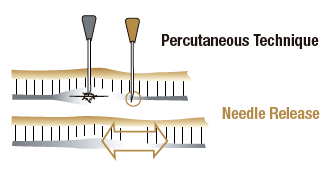The Hand & Wrist Center
3633 Long Beach Boulevard, Suite 100
Long Beach, CA 90807
Phone: (562) 424-9000
Monday - Friday: 8:00 a.m.–5:00 p.m.
The Needle Aponeurotomy Procedure
The goal of Needle Aponeurotomy is to simply release tight Dupuytren’s cords present to allow the involved digits to extend without forming scar tissue. NeedleAponeurotomy is a minimally-invasive procedure, which is performed under local wheal anesthesia. During the procedure, a small needle inserted through the skin percutaneously cuts (or releases) the underlying tight cord(s). Once the cord has been penetrated (cut) by the needle, the “break” allows for the contracture to release, thus allowing digital and palmar extension to occur immediately.
About the Procedure
The primary focus of this procedure is to provide as many releases as possible along the tight cord, while minimizing the formation of scar tissue. Needle Aponeurotomy is not a cure for Dupuytren’s Disease, but it provides a less-invasive method by which this condition can be treated without traditional, open surgery. Simultaneous cortisone injections may be administered during this process, which is believed to help shrink and soften nodules, as well as discourage reformation of the cells that cause palmar cords.
Dr. Ross Nathan uses a technique similar to the one described by Dr. Charles Eaton (“The Eaton Procedure“). This procedure entails the simultaneous cutting and injecting of the contracture (cord), which then facilitates nicking it beneath the skin, causing the cord to break (release). The diagram below illustrates The Eaton Procedure approach.

(Source: © 2007 Charles Eaton, M.D., www.handcenter.org)
Consultation and Preparation for the Procedure
During your consultation, our Physician will discuss with you the procedure, risks and benefits, and other expectations. Photographs will be taken of your hand before the procedure to document the severity of your contracture(s), and after the procedure we will take new photographs to document the degree of correction. A copy of these photographs can be provided to you for your records. Additionally, prior to the procedure, our Physician will mark (needle “portal” sites) with a surgical skin marker along the areas of the hand contracture where he will be performing your procedure. This is done before the procedure so you are completely aware of the procedure sites.
When and Where Can This Procedure Be Performed?
Needle Aponeurotomy is best performed in our Office, under a local (injection) anesthetic block. During this procedure the patient can expect to be fully awake. Local anesthesia eliminates unnecessary trips to a hospital or surgery center, as well as expensive preoperative work-up and operating-room costs. The procedure, in most instances, can be performed within approximately 30-60 minutes. The procedure can be performed on the same day as your consultation, or on a separate, more convenient day.
We usually recommend that Needle Aponeurotomy be performed on only one hand at a time. Performing separate procedures for each hand can greatly minimize potential complications, shorten the soft-tissue healing period and it allows for use of the other hand for hygiene. If you must have same-day, both hand-procedures done, please inform our Physician and Staff so that we can discuss this option with you.
What to Expect During the Procedure
During your procedure, you will lay supine (face-up) on a padded procedure table with pillows under your head and legs. Your hand will be extended away from your body on a surgical table for our Physician’s access.
After the hand is cleansed with an antiseptic solution, a small tuberculin-type syringe will be used to inject a small amount of local anesthesia into the sites of the Needle Aponeurotomy procedure. During the procedure, various sites along the contracted cords are utilized as “portals.” Through these sites, a small needle is placed as the tight cords are then divided. This is performed at various intervals “interarch” to achieve the best correction. Thick nodules present at the cord sites may be injected with a dilute cortisone preparation, which may help minimize recurrence. In addition, and when indicated, contracted finger joints may be injected with the same dilute cortisone preparation to assist with obtaining maximal correction of extension.
In order to minimize nerve and deep flexor tendon injury, and to asses needle-tip location, our Physician will repeatedly assess sensibility by asking you to gently flex (bend) your fingertip and/or inform him if you feel numbness, tingling and/or pain at any site. This is one of the reasons why “being awake” during your procedure is important.
What to Expect Following the Procedure
Once our Physician has determined that there are no further sites to inject or release, we will then proceed to immediately clean up our working area before asking you to sit up. Our Physician will then discuss and show you the results of the procedure after taking final measurements of joint positions and digital pictures. Small bandaid dressings will be applied to the portal sites, and a palm-sized icepack will be secured to the palm with an elastic wrap.
If you would like to learn more about Needle Aponeurotomy for Dupuytren’s Contracture, request a consultation, or phone the The Hand & Wrist Center at (562) 424-9000.
Back to Top